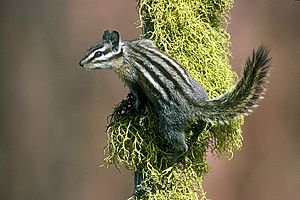Yellow-pine chipmunk facts for kids
Quick facts for kids Yellow-pine chipmunk |
|
|---|---|
 |
|
| Conservation status | |
| Scientific classification | |
| Genus: |
Neotamias
|
| Species: |
amoenus
|
 |
|
| Synonyms | |
|
Tamias amoenus J.A. Allen, 1890 |
|
The yellow-pine chipmunk (Neotamias amoenus) is a small, striped animal. It belongs to the group of animals called rodents. These include animals like mice, rats, and squirrels. The yellow-pine chipmunk is part of the squirrel family, known as Sciuridae.
You can find these chipmunks in western North America. They live in parts of Canada and the United States. They often make their homes in areas with lots of bushes. In California, they live in mountains at heights from about 975 to 2,900 meters (about 3,200 to 9,500 feet) above sea level.
Contents
What Does the Yellow-Pine Chipmunk Look Like?
Yellow-pine chipmunks have a dark, reddish-brown body color. It looks a bit like cinnamon. They have five dark stripes running down their back. These stripes are separated by four lighter stripes.
- The two outer light stripes are narrow and creamy white.
- The two middle light stripes are gray.
On each side of their head, they have three dark stripes with two lighter ones in between. The top of their head is black or gray.
Male and female chipmunks are quite similar in size. Their brains, tail length, and ear length are about the same. However, female yellow-pine chipmunks are usually a bit bigger overall. For example, large males weigh about 49.7 grams, while large females weigh around 53.5 grams.
Sometimes, it can be hard to tell a yellow-pine chipmunk apart from other chipmunks. This is especially true if they live in the same areas as the least chipmunk or red-tailed chipmunk. Scientists might need to study their bones to know for sure.
How Yellow-Pine Chipmunks Find Food
Yellow-pine chipmunks are animals that store seeds for the winter. They also hibernate, which means they go into a deep sleep during the cold months. Their health in winter and spring depends on how much food they can find. It also depends on how well they gather food in summer and autumn.
These chipmunks do not get fat before they hibernate. Instead, they build a "larder," which is like a pantry filled with food for winter. The size of their larder helps them survive winter. It also affects how successful they are at having babies in the spring.
During the warmer months, chipmunks collect seeds they find. They hide these seeds in many different spots, called "caches." Later, they will dig up these hidden seeds to add to their winter larder. Yellow-pine chipmunks are careful not to hide their food too close together. Their hidden food spots are usually about 1.4 to 4.9 meters (about 4.6 to 16 feet) apart. The farther they are from their main food source, the more spread out their hidden caches become.
Reproduction and Life Cycle
After waking up from hibernation, yellow-pine chipmunks breed once a year. This usually happens in late April or early May. A female chipmunk will mate with one or more males near her den.
- A female usually gives birth to about four or five babies.
- Births happen in late May or early June.
- If a mother has six babies, they tend to be smaller. This suggests it's a lot of work for the mother!
- The mother feeds her babies milk for about two months.
- By early September, the young chipmunks are about the same size as other chipmunks in the area.
Female chipmunks that are larger tend to have more success in having babies. For male chipmunks, their size does not seem to affect how successful they are at reproducing.
See also
 In Spanish: Ardilla de pino amarillo para niños
In Spanish: Ardilla de pino amarillo para niños


